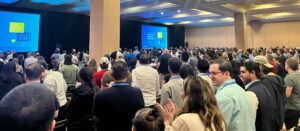Solution Design Sprints + Design Thinking is a methodology for approaching analytics product development that combines elements from human centered design, design thinking, system thinking and product management to guide BI development teams through a robust yet approachable analytics product lifecycle.
Do these scenarios resonate with you:
- Have you ever built a dashboard that wasn’t used or was quickly abandoned?
- Have you poured a lot of time into building an amazing dashboard only to find it didn’t get used?
- Have you created an amazing dashboard only to find that your users reverted back to their “old ways” of doing things?
Oftentimes, results like these are due to centering our development process around something other than our end users. Whether this is the data, a specific functionality, or a certain chart type – if it’s not the users, we’re probably going to end up down the wrong path.

Above: a crowd preparing for the User-Centered Dashboard Development presentation at Tableau Conference 2022
How Can Solution Design Sprints + Design Thinking Help?
When we shift our mindset to thinking of users as collaborators in the development process, we are able to approach the experience with a more open mindset.
In our Tableau Conference talk this year, my colleague Keith Dykstra shared our 3 Key Principles:
- Start with users, not with the data.
- Not just users first, but users throughout.
- Don’t build it and forget it. Build it and nurture it.
Start with Users, Not with the Data
As mentioned before, it’s imperative that we begin our development process with users. We must not only listen to the requests of users (where our initial dashboard request probably came from), but we must engage in a conversation with them to get at the heart of their business needs.
It’s risky at this stage to take new dashboard requests at face value. This is our chance to shift out of a “developer” mindset and into that of a “product manager,” where we get curious and ask questions to explore the context around our users’ requests. By exploring the deeper layers of a request, we can better understand our users and put together a more robust and targeted solution than what was originally requested.
Not Just Users First, but Users Throughout
After homing in on the unique problem of our users, it’s time to come up with solutions to solve that problem. At this phase it can be tempting to take your first idea and build it out fully in Tableau before re-engaging with your users. We want to put our best foot forward, right?
Well, of course. But actually, the way to put our best foot forward in this situation is to share works in progress instead of works of perfection. When I first started dashboarding, I wanted things to be pixel perfect before showing end users, even with my first pass of an idea. What ultimately ended up happening was that I became too attached and spent too much time building something that was ultimately going to change after user feedback anyways.
By engaging in rapid prototyping of ideas and showing users various versions of our dashboard along the way, we can create a more continuous feedback loop that allows us to fine tune our dashboard as we go without too a big investment of time and energy up front.

Above: Keith Dykstra presenting User-Centered Dashboard Development at Tableau Conference 2022
Don’t Build It and Forget It. Build It and Nurture It
With all of our busyness at work, it’s tempting to build a dashboard, publish it to production, check the box that says “done” on our to-do list and call it a day. But we do ourselves a disservice by forgetting about a dashboard after it goes out to our users. This is when we really need to start listening to what our wider audience of users are saying (or not saying) about the dashboard.
Solution Design Sprints + Design Thinking encourages us to treat our dashboards less as stagnant tools and more as living solutions that evolve with the ever-changing needs of our users. By providing a mechanism for users to provide ongoing feedback, we continue the conversation which enables us to create robust lifecycles for our dashboards that extend way beyond the initial release.
So, What Now?
If this concept of Solution Design Sprints + Design Thinking resonates with you, but you’re unsure how you could make it work in your workplace, reach out to us for a discussion! We’d love to hear your unique challenges when it comes to managing dashboard lifecycles and brainstorm ideas of how it could be better. You can reach out through our contact page to inquire about a session, or if you’re already an InterWorks customer, you can ask your Account Executive.

